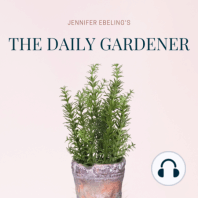10 min listen

July 18, 2019 Growing Chervil, Gilbert White, Jane Austen, Frederick Law Olmsted, Eleanor Sinclair-Rhode, A Southern Garden by Elizabeth Lawrence, Ir…
July 18, 2019 Growing Chervil, Gilbert White, Jane Austen, Frederick Law Olmsted, Eleanor Sinclair-Rhode, A Southern Garden by Elizabeth Lawrence, Ir…
ratings:
Length:
10 minutes
Released:
Jul 18, 2019
Format:
Podcast episode
Description
Have you tried growing the herb chervil? Chervil tastes similar to tarragon - it's sometimes called gourmet parsley. It has a wonderful fern-like leaf which turns red in the fall which is another plus. August is a wonderful time to sow chervil - so keep that in mind. The 1884 Dictionary of English Names of Plants lists chervil as “the shepherd’s clock’’ because the blossoms open at five in the morning and then close up around eight in the evening. The word chervil is derived from a Greek word meaning “the herb of rejoicing’’ or “the cheer leaf." Brevities #OTD It's the birthday of the English naturalist, Gilbert White, who was born on this day in 1720. White kept a journal for almost three decades where he recorded observations of his garden. It was eventually published as a Calendar of Flora and the Garden, followed by the Naturalist’s Journal. People immediately recognized White had a gift for observation and for describing with vivid clarity the goings-on in the natural world. Here's a little of what he wrote in his journal on this day in 1781; his 61st birthday: "Farmers complain that their wheat is blited. In the garden at Dowland’s,... stands a large Liriodendrum tulipifera, or tulip-tree, which was in flower. The soil is poor sand; but produces beautiful pendulous Larches. Mr R’s garden, ... abounds in fruit, & in all manner of good & forward kitchen-crops. Many China-asters this spring seeded themselves there... some cucumber-plants also grew-up of themselves from the seeds of a rejected cucumber thrown aside last autumn. Mr R’s garden is at an average a fortnight before mine." #OTD Today is the anniversary of the death of the author and gardener Jane Austen. Austen loved gardens. She had a heart for ornamentals, herbs, and kitchen gardening. Her family always had a garden - growing their own food and beautifying their homes with flowers. In every single one of her books, Austen included gardens. We know from Austen's letters to her sister, Cassandra, that gardens brought her joy and they were also regulating. In 1807, she wrote about the redesign of her garden: "I could not do without a syringa... We talk also of a laburnum. The border under the terrace wall is clearing away to receive currants and gooseberry bushes, and a spot is found very proper for raspberries." In 1814, she wrote about the garden outside her rented room, "The garden is quite a love... I live in the room downstairs, it is particularly pleasant...opening upon the garden. I go and refresh myself every now and then, and then come back to Solitary Coolness." #OTD It was on this day in 1863 that the father of American landscape architecture, Frederick Law Olmsted, walked the battlefield of Gettysburg, just 15 days after the battle. Olmsted was the General Secretary of the United States Sanitary Commission (USSC) - overseeing the support of sick and wounded soldiers of the United States Army during the Civil War. At times, Olmsted personally treated the battlefield wounds of soldiers. Olmsted was handpicked for the job thanks to his success in designing and overseeing New York City's Central Park, one of the country's largest public works projects. A week after the battle at Gettysburg, Olmsted arranged for 40 tons of supplies to flow into Gettysburg every day - bringing in items like surgeon’s silk, fans, butter, shoes, and crutches. By July 18, the scene had settled down enough that Olmsted could walk the fields of Gettysburg. In Martin's biography of Olmsted, he shared that Olmsted, "was struck by the scale of the place; everything had happened across distances far greater than he had supposed." Ever attuned to the landscape, Olmsted also noted that, "The hills were gentle and rolling, so very out of kilter with the carnage that was everywhere still in evidence... Olmsted came across spent shells and twisted bayonets, broken-down wagons and half-buried dead horses. Particularly touching, to Ol
Released:
Jul 18, 2019
Format:
Podcast episode
Titles in the series (100)
May 2, 2019 Plant Sales, May Fools Day, Rivdan, The White House Gardens Symposium, Jimi Hendrix, Stonewall Jackson, Didier Decoin, Dividing Iris, and The Enid A. Haupt Garden: Ah May... the Month of Plant Sales. When I started gardening, I would Plant Sale away my Saturdays in May with my dear friend Judy. We would plan our way to a successful sale day, waking up while it was still dark out. Then... by The Daily Gardener